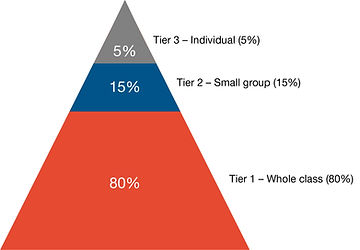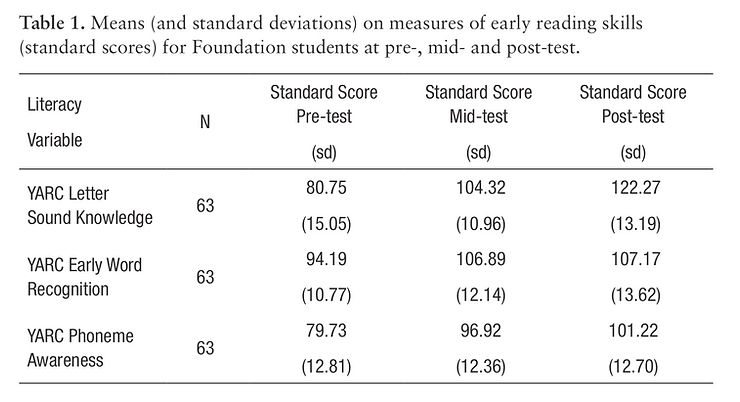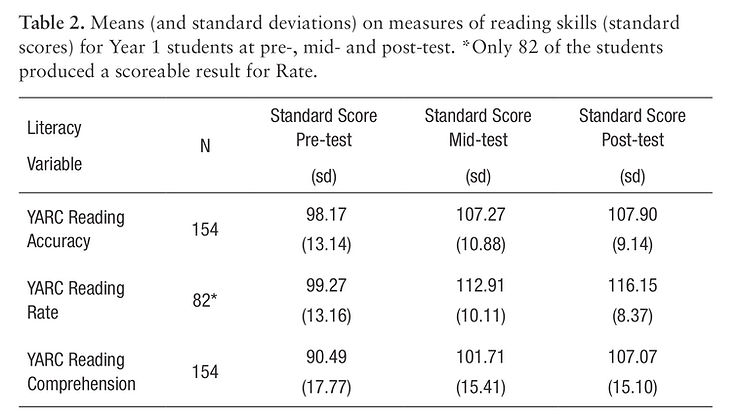
Starting off on the right foot for reading
Exemplary Tier 1 instruction must be the bedrock of the Response to Intervention model.
By Kevin Wheldall
Following the demise of the discredited discrepancy model for defining reading disability, whereby children’s reading performance was typically compared with their overall general ability, the focus for understanding and, in a sense ‘diagnosing’ and ‘treating’, reading disability has turned to the Response to Intervention (RtI) model. Rather than identifying children as having a reading difficulty because their reading performance was significantly inferior to what might be expected from a knowledge of their overall general ability, the RtI model argues for a phased intervention model of increasing support, determined by regular monitoring of the child’s reading progress.
In the widely adopted three-tier pyramid model of RtI, it is anticipated that 80% of children will make good progress towards learning to read, given exemplary ‘universal’ or Tier 1 whole class instruction. A further 15% are likely to be caught up or ‘recovered’ by the provision of Tier 2 small group supplementary reading instruction based on evidence-based best practice, leaving only 5% who are likely to need even more intensive Tier 3, one-to-one instruction specifically geared to help the individual child learn to read. A diagram of this ‘pyramid’ model is shown below. This is the received wisdom but this version of the model may be unnecessarily pessimistic. To a large degree, the model hinges on the adequacy of the universal whole-class instruction provided at Tier 1.

Exemplary Tier 1 instruction, in our view, should necessarily address the Five Big Ideas of reading instruction: phonemic awareness, phonics, fluency, vocabulary and comprehension. While, arguably, phonemic awareness, fluency, vocabulary and comprehension are quite often addressed in many whole language lessons in Australia, phonics instruction is often neglected, or taught as a secondary consideration; phonics as the method of last resort. Moreover, when phonics is taught it is more likely to be taught as analytic or incidental phonics rather than as systematic synthetic phonics (SSP). It is little wonder, then, that in some schools (especially those in less advantaged areas), large percentages are found to be in need of Tier 2 provision at the beginning of Year 1; sometimes 50% or more of children are located in the bottom quartile (25%) for reading performance. These children are not necessarily brought up to the level of their peers and so we may see similar percentages at the end of Year 1, in some schools. This has resulted in far too many children who would otherwise have learned to read with relative ease, failing to do so; so-called ‘instructional casualties’.
If at least 80% of children are not making adequate progress, as the RtI model predicts that they should, then clearly there is something wrong with the Tier 1, universal, whole class provision on offer. It cannot be considered exemplary. The RtI model effectively provides us with a means of judging the adequacy of our Tier 1 instruction.
Developing programs of effective Tier 1 initial instruction
It was these considerations that led us to expand our focus within MultiLit and to begin to develop programs of exemplary initial instruction in literacy, to meet the needs of all students for the years Foundation (Kindergarten/Reception/Prep) to Year 2. Our MultiLit Product Development Team and the MultiLit Research Unit have been working together for some five years to develop an effective, coordinated and articulated suite of programs of initial instruction, known as InitiaLit. The first of the three programs, InitiaLit-F (for Foundation), for young children in their first year of schooling, was released in 2017. The follow-up program, InitiaLit-1, to continue instruction in reading and related skills for students in their second year of schooling, was released last year (2018), and the final program in the InitiaLit suite, for Year 2 students, will be published later in 2019.
InitiaLit is a suite of instructional programs for whole classes that reflects both advances in scientific research in reading instruction and the concomitant changes in our thinking and conceptualisation of reading instruction within MultiLit. This includes the series of decodable readers that accompany both the Foundation and Year 1 programs. All three of the programs address the Five Big Ideas. They are certainly not exclusively ‘phonics programs’ but systematic synthetic phonics (SSP) does feature strongly, especially in the first two programs.
Preliminary findings from field trials
During the research and development phase, we have continually carried out numerous field trials of varying levels of sophistication, most of which have not involved formal data collection. They were carried out to see how well the programs worked in the real world of classrooms and changes were made on the basis of teacher feedback and our observations.
We have, however, also carried out preliminary data-based trials of the draft programs in which students were assessed on program entry, again after two terms of instruction and again at the end of the year, by trained research assistants administering standardised tests of reading and related skills. For our present purposes, we shall summarise some of the results from those tests that provide standard scores and percentiles based on Australian norming studies, in this case the York Assessment of Reading for Comprehension (YARC) Early Reading and the YARC Passage Reading Primary.
Looking first at the findings for the Foundation year, 63 students from two schools completed all 126 lessons comprising the InitiaLit-Foundation program. The students made statistically significant average gains in raw score over the year with large effect sizes on all measures of early reading skills, including letter sound knowledge, word recognition and phoneme awareness. But we would expect most children to make some gains, regardless of the type of instruction they received, over the course of a year in school. So, let’s look instead at the mean standard scores, which take increasing age into account, to see if they made appreciable gains compared to the norming sample. (Note that these estimates of average performance are conservative because at pre-test, up to 43% of the students scored below the range of standard scores provided by the test and hence the mean average pre-test score is overestimated; at mid-test, 7% of students or less scored below this range.)
Table 1 shows the students’ average progress in terms of standard scores on the three YARC Early Reading measures.

These results clearly provide good preliminary evidence for the efficacy of the program; the average gains in standard scores over the year are substantial. But it is the effects on the distribution of scores to which we wish to draw particular attention.
We shall return to this following a brief description of the parallel findings for Year 1 of InitiaLit instruction. Three schools and a total of 153 Year 1 students were involved, all of whom received instruction in the InitiaLit Year 1 program. Again, over the year, these students made statistically significant average gains in raw score with large effect sizes on all measures of reading skill, as we would expect.
Table 2 shows the students’ average progress in terms of standard scores on measures of reading skill as measured by the YARC Passage Reading Primary. It should be emphasised that any gains in standard scores represent improvements relative to the students’ peer group. Thus, the current results indicate that students made substantial gains, on average, attaining these skills at a greater rate than their peers.

Changes in the standard score distributions
Let us now look at the changes in distribution of scores and relate these to what we might expect from the RtI model. Following InitiaLit, if it is an exemplary Tier 1 program, then there should be only 20% of students remaining in need of Tier 2 (or Tier 3) support.
Further analysis of the Foundation Year sample revealed that there was a considerable shift of students out of the bottom quartile (bottom 25% of same aged students) to the average range (middle 50% of same aged students) and top quartile (top 25% of same aged students) between pre- and post-test.
At pre-test, 75% of students scored in the bottom quartile for letter sound knowledge and only 6% scored in the top quartile. By post-test, while 6% remained in the bottom quartile, 89% of students scored in the top quartile.
Similarly, on the measure of phoneme awareness, 79% of students scored in the bottom quartile and only 3% scored in the top quartile at pre-test. By post-test, only 14% of students remained in the bottom quartile and 22% scored in the top quartile.
For word recognition, 19% of students were in the bottom quartile and 8% were in the top quartile at pre-test. By post-test, 16% scored in the bottom quartile and 51% were now in the top quartile.
These results indicate that InitiaLit-F may have helped to reduce the number of students who might have struggled to learn to read (those in the bottom quartile) while not limiting the growth of higher performing students, as indicated by those moving from the average range to the top quartile.
Similarly, further analysis of the Year 1 sample also showed that there was a considerable shift of students out of the bottom quartile to the average range and top quartile between pre- and post-test.
35% of students scored in the bottom quartile at pre-test, for reading accuracy and 26% scored in the top quartile. At post-test, while only 6% remained in the bottom quartile, the majority (51%) of students scored in the top quartile.
Similarly, for reading rate, at pre-test 28% of students scored in the bottom quartile and 23% scored in the top quartile. By post-test, only 1% of students remained in the bottom quartile and 83% scored in the top quartile.
For reading comprehension, 43% of students were in the bottom quartile and 27% were in the top quartile at pre-test. By post-test, only 16% remained in the bottom quartile and 47% were now in the top quartile.
Again, these results for Year 1 indicate that InitiaLit-1 may have helped to reduce the number of students who might have struggled to learn to read (those in the bottom quartile) while not limiting the growth of higher performing students, as indicated by those moving from the average range to the top quartile.
Conclusions
Arguing from RtI theory and the above, an exemplary Tier 1 whole class program should be effective for 80% of the sample, leaving only 20% in need of Tiers 2 and 3. So we might expect at least 20% to be in the bottom quartile by the end of Year 1 after one year of Initialit instruction. But InitiaLit, on the whole, is typically delivering more than this, as the figures above show; on no measure for either InitiaLit Foundation or InitiaLit Year 1 are the post-test percentages in the bottom quartile greater than 20%, and usually substantially less. The need for further Tier 2 or 3 instruction would appear to be greatly reduced. (Note that a large proportion of the Year 1 sample were from LOTE backgrounds and this may partly explain the figure of 16% for comprehension.)
These preliminary data indicate that students receiving instruction in the InitiaLit programs can make excellent gains in measures of early reading and related skills over and above the typical progress of their same aged peers. They also indicate that the program may assist struggling students to catch up, as indicated by those students moving out of the bottom quartile, while not limiting the growth of higher performing students, as indicated by the movements into the top quartile. An example of this is shown in the bar graph below for reading accuracy performance of the InitiaLit-1 students across the year.
To this extent, the most popular version of the three tier, pyramid model of RtI may be viewed as somewhat pessimistic about the percentages of students who are likely to be in need of Tiers 2 and 3 levels of instruction, following exemplary Tier 1 whole class instruction. These preliminary findings from our trials suggest that far fewer students will need additional support following Tier 1 programs like InitiaLit. This will have the effect of providing support for struggling young readers much more manageable for most schools because far fewer students will need this level of additional support and, hence are more likely to be ‘recovered’ early in their acquisition of reading and related skills.
Kevin Wheldall AM is an Emeritus Professor of Macquarie University and is Chairman of MultiLit Pty Ltd.
This article appeared in the June 2019 edition of Nomanis: www.nomanis.com